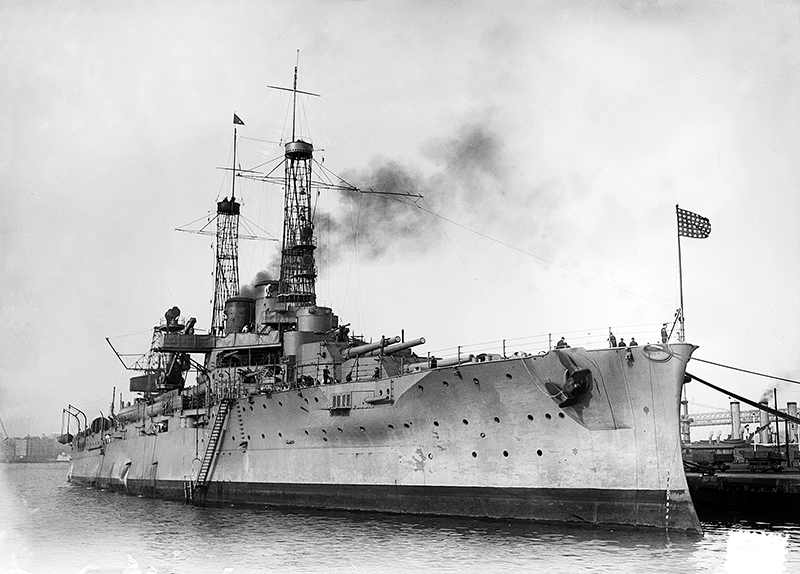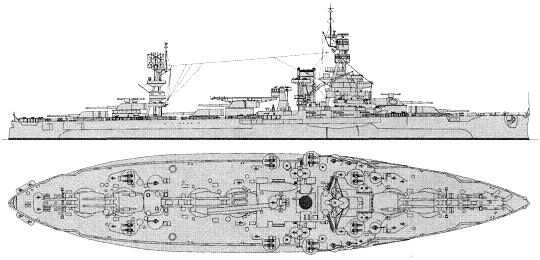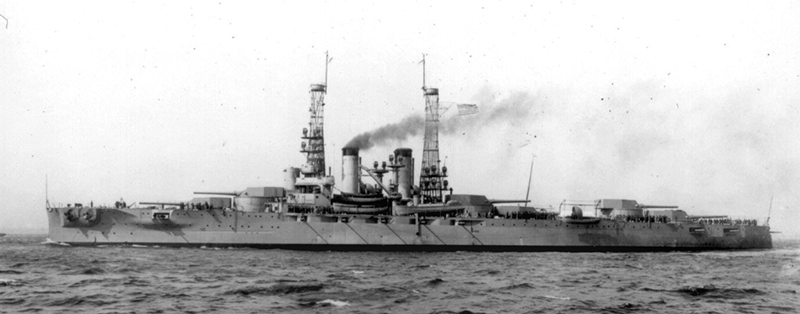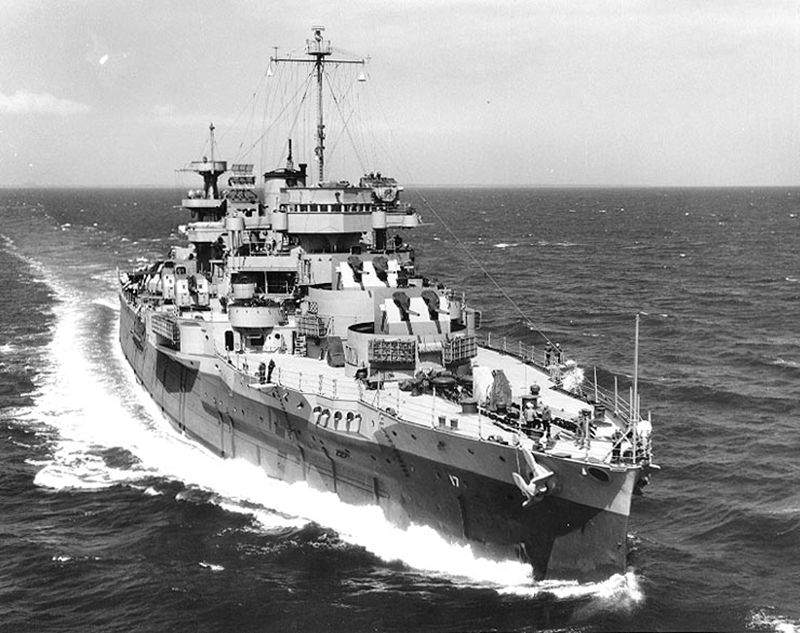
NAVYPEDIA
 Support the project with paypal
Support the project with paypal
Photo

Arkansas
Ships
| No | Name | Yard No | Builder | Laid down | Launched | Comm | Fate |
|---|---|---|---|---|---|---|---|
| BB32 | Wyoming | 365 | Cramp, Philadelphia | 9.2.1910 | 25.5.1911 | 25.9.1912 | gunnery TS 7.1931, stricken 9.1947 |
| BB33 | Arkansas | 97 | New York SB, Camden | 25.1.1910 | 14.1.1911 | 17.9.1912 | sunk at nuclear tests 26.7.1946 |
Technical data
| Data variant | as completed | 1926-1927 modernization |
|---|---|---|
| Displacement standard, t | --- | 26066 |
| Displacement normal, t | 26000 |
|
| Displacement full, t | 27243 |
30610 |
| Length, m | 168.9 wl 171.3 oa |
168.9 wl 171.3 oa |
| Breadth, m | 28.4 |
32.3 |
| Draught, m | 8.70 |
9.13 full load |
| No of shafts | 4 |
4 |
| Machinery | 4 Parsons steam turbines, 12 Babcock & Wilcox boilers |
4 Parsons steam turbines, 4 White Foster boilers |
| Power, h. p. | 28000 |
28000 |
| Max speed, kts | 20.5 |
21 |
| Fuel, t | coal 2650 + oil 400 |
oil 3786 (5543 max) |
| Endurance, nm(kts) | 5190(12) | 14000(10) |
| Armour, mm | belt: 280 - 229, upper belt: 280 - 229, casemate: 165, deck: 38, barbettes: 280, turrets: 305 (face), CT: 292 |
belt: 229 - 280, deck: 67 - 119, bulkhead: 280, barbettes: 280 - 114, turrets: 305 (face), CT: 292 |
| Armament | 6 x 2 - 305/50 Mk VII, 21 x 1 - 127/51 Mk VII, 2 - 533 TT (beam) |
6 x 2 - 305/50 Mk 7, 16 x 1 - 127/51 Mk 7.8, 8 x 1 - 76/52 Mk 10, 1 catapult, 3 seaplanes (UO) |
| Complement | 1063 |
1242 |
Standard scale images

Arkansas 1942

Wyoming 1912
Graphics
Project history
Design of 1909 program batleships was developed as one of three alternatives, after President Theodore Roosevelt asked in 1908 whether the United States should not go from 305mm to 356mm guns: a 12x 305mm design, an 8x 356mm design, and a 10x 356mm design. At this time there was a widespread feeling that the standard of battleships caliber would soon rise above 305mm. For example, there were already reports that Britain had a 343mm gun under construction. The 305mm alternative was chosen in 1909 largely because it entailed the least delay, and because it was the largest ship that could be docked in existing facilities on both coasts, whereas the 10x 356mm ship could be docked only at Pearl Harbor and Puget Sound, and at New York only if the dock there could be lengthened by 1.5m. Therefore the decision was to build and test the 356mm gun, and to enlarge docking facilities, so that the more satisfactory ship could be built later. That became the New York class, built under the 1910 (FY 11) program. The Wyoming design was accepted as an interim solution, particularly after the Bureau of Ordnance had developed a new 50-calibre 305mm gun to arm it.
All of these designs were flush-deckers. The World Cruise had already shown the problems of mounting secondary guns too low, and the solution adopted was to slope the main deck from a high bow aft, gaining about 1.2m in secondary battery height amidships.
Ship protection
Main 122m-long belt had 2.44m height (1.3m over and 1.14m under waterline) abreast citadel and was 280mm thick at upper part tapering to 229mm at lower edge. Belt was connected with end barbettes by 280mm fore and 229mm aft bulkheads. There was narrow 127mm belt between barbette No6 and stern. There was 2.21m-high upper belt, 280mm at lower and 229mm at upper edges, it was closed by 229mm bulkheads. Casemate had 165mm armour and connected with barbettes No2 and 3 by diagonal 165mm bulkheads. Funnel uptakes had 165mm protection. Flat armoured deck connected with upper edge of main belt and was 57mm over boilers and 76mm over magazines. Main deck over turbines (between No4 and 5 barbettes) was unprotected. This deck had 38mm thickness from citadel to stem. It was 51mm aft from citadel and was strengthened over steering gear up to 76mm with 76mm slopes. Battery deck was connected with upper edge of upper belt and was 25mm between No2 and 6 barbettes, increasing to 44mm under casemate. Main gun turrets had 305mm faces, 203mm sides and rears and 76mm crowns. Barbettes were 254mm at upper and 102mm at lower edges. CT had 76mm roof. Underwater protection was 7.4m deep. There was 38mm longitudinal bulkhead.
Ship protection after modernization: Main 122m-long belt had 2.44m height (1.3m over and 1.14m under waterline) abreast citadel was 280mm thick at upper part tapering to 229mm at lower edge. Belt was connected with end barbettes by 280mm fore and 229mm aft bulkheads. There was narrow 127mm belt between barbette No6 and stern. There was 2.21m-high upper belt, 280mm at lower and 229mm at upper edges, it was closed by 229mm bulkheads. Casemate had 165mm armour and connected with barbettes No2 and 3 by diagonal 165mm bulkheads. Funnel uptakes had 165mm protection. Old flat armoured deck (now splinter deck) connected with upper edge of main belt and was 57mm over boilers and 76mm over magazines. Main deck over turbines (between No4 and 5 barbettes) was unarmoured. This deck had 38mm thickness from citadel to the stem. It was 51mm aft from citadel and was strengthened over steering gear up to 76mm and had 76mm slopes. New main deck (old battery deck) was connected with upper edge of upper belt and was 114mm over magazines, 120mm over boilers and 132mm over turbines. Main gun turrets had 305mm faces, 203mm sides and rears and 120mm crowns. Barbettes were 254mm at upper and 102mm at lower edges. CT had 120mm roof. Underwater protection was 9.0m deep. There was 38mm longitudinal bulkhead.
Modernizations
1916, both: + 4 x 1 - 76/52 Mk X
1918, both: + 4 x 1 - 76/52 Mk X
early 1919, both: thickness of turrets and CT roofs was increased to 152mm.
9/1919, both: - 5 x 1 - 127/51
(8/1927 - 11.1927, Philadelphia NYd) Wyoming; (9/1925 - 11.1926, Philadelphia NYd) Arkansas: were modernized as given in the table. New bulges and boilers were fitted, horizontal armour was strengthened, part of secondary guns was moved one deck up.
1931, Wyoming: was converted to TS. Armoured belt, turrets No 4, 5 and 6 and part of boilers were removed. Her armament in 1944 consisted of 4 x 2 - 127/38 Mk 12, 2 x 1 - 127/38 Mk 12, 4 x 1 - 127/25 Mk 10, 4 x 1 - 76/50 Mk 17/20/21, 1 x 4 - 40/56 Mk 1.2, 4 x 2 - 40/56 Mk 1.2, 2 x 1 - 40/56 Mk 1.2, (8 - 15) - 20/70 Mk 4.
7/1942, Arkansas: maximal 305mm guns elevation angle was increased to 30°. - 10 x 1 - 127/51; + 2 x 1 - 76/50 Mk 20, 4 x 4 - 28/75 Mk 1, 20 x 1 - 20/70 Mk 4, SC, SG, SK, FC (Mk 3) radars
9/1942, Arkansas: + 2 x 4 - 28/75 Mk 1
12/1942, Arkansas: + 2 x 4 - 28/75 Mk 1, 6 x 1 - 20/70 Mk 4
5/1943, Arkansas: - 8 x 4 - 28/75; + 8 x 4 - 40/56 Mk 1.2
5/1944, Arkansas: - 4 x 1 - 20/70; + 2 x 4 - 20/70 Mk 4
11/1944, Arkansas: + 2 x 1 - 76/50 Mk 20, 1 x 4 - 40/56 Mk 1.2, 6 x 1 - 20/70 Mk 4, SG (2nd), 2x Mk 19 radars
1/1946, BB33 Arkansas: 6 x 2 - 305/50 Mk 7, 6 x 1 - 127/51 Mk 13, 8 x 1 - 76/50 Mk 11, 9 x 4 - 40/60 Mk 2, 2 x 4 - 20/70 Mk 15, 28 x 1 - 20/70 Mk 10, 1 catapult, 3 seaplanes, radars: SC, 2 x SG, SK, FC (Mk 3), 2x Mk 19
Naval service
Wyoming in 1931 was partially disarmed (according to London Naval Conference) and further used as a gunnery TS. Arkansas was foundered next day after nuclear-weapon tests at Bikini 25.7.1946.
 HOME
HOME FIGHTING SHIPS OF THE WORLD
FIGHTING SHIPS OF THE WORLD UNITED STATES OF AMERICA
UNITED STATES OF AMERICA CAPITAL SHIPS AND MONITORS
CAPITAL SHIPS AND MONITORS WYOMING battleships (1912)
WYOMING battleships (1912)



